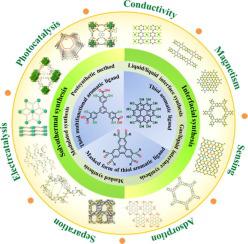Coordination Chemistry Reviews ( IF 20.3 ) Pub Date : 2021-10-08 , DOI: 10.1016/j.ccr.2021.214235 Xiangling Deng 1, 2 , Sai-Li Zheng 1 , Yuan-Hui Zhong 1 , Jieying Hu 1 , Lai-Hon Chung 1 , Jun He 1

|
In old days, application of MOFs in the field of electrochemical catalysis and electronic device fabrication was not common because MOFs generally exhibited low electrical conductivity. However, within these decades, various approaches have been developed for assembling electrically conductive MOFs. Among these approaches, using thiol-functionalized linkers to assemble thiol-decorated MOFs (thiol-MOFs) represents a novel and effective way since sulfur groups facilitate interlayer charge delocalization and hence electrical conductivity in MOFs. Generally speaking, thiol-MOFs can be generally divided into two types: (1) structure constructed from soft metal ions and dithiolene linker molecules with planarity, π-conjugation and redox activity; (2) framework assembled from hard metal ions and linker molecules with both carboxyl and thiol groups, where thiol (–SH) groups exist as free-standing functional group or coordinating group in robust porous coordination networks. Gratifyingly, some of the reported MOFs bearing thiol-functionalized ligands have shown outstanding electrical conductivity which highlight the thiol-MOFs as future materials in the field of conductive/semiconductive MOFs. Unfortunately, the demanding synthetic conditions of thiol-functionalized linkers (such as the foul odor of sulfur reagents, harsh synthetic conditions), poor crystallinity of thiol-MOFs and difficult characterization of unstable thiol-MOFs discourage extensive exploration of this linker family and its MOF derivatives. Despite the difficulty, exploration of these thiol-MOFs still made progress in recent years. To make sulfur-functionalized linkers and MOFs more popular, design strategies and synthetic protocols of thiol-functionalized linkers, growing strategies of thiol-MOFs and recent advances of thiol-MOFs in different application studies are discussed in this review. At last, a perspective is given to cover the future prospect of thiol-functionalized linkers and thiol-MOFs so as to provide insights for researchers interested in investigating thiol-MOFs.
中文翻译:

基于硫醇功能化接头的导电 MOF:挑战、机遇和最新进展
在过去,MOFs 在电化学催化和电子器件制造领域的应用并不普遍,因为 MOFs 通常表现出低电导率。然而,在这几十年中,已经开发了各种方法来组装导电 MOF。在这些方法中,使用硫醇官能化的接头组装硫醇修饰的 MOF(硫醇-MOF)代表了一种新颖而有效的方法,因为硫基促进了层间电荷的离域,从而促进了 MOF 的导电性。一般来说,硫醇-MOFs一般可分为两类:(1)由软金属离子和具有平面性、π共轭和氧化还原活性的二硫烯连接分子构成的结构;(2) 由硬金属离子和具有羧基和硫醇基团的连接分子组装而成的框架,其中硫醇(-SH)基团作为独立的官能团或配位基团存在于坚固的多孔配位网络中。令人欣慰的是,一些已报道的带有硫醇官能化配体的 MOFs 表现出出色的导电性,这突出了硫醇-MOFs 作为导电/半导体 MOFs 领域的未来材料。不幸的是,硫醇官能化接头的苛刻合成条件(如硫试剂的恶臭、苛刻的合成条件)、硫醇-MOF 的结晶度差以及不稳定的硫醇-MOF 难以表征,阻碍了对该接头家族及其MOF 的广泛探索衍生品。尽管困难重重,但近年来对这些硫醇-MOFs的探索仍然取得了进展。为了使硫功能化接头和 MOF 更受欢迎,本综述讨论了硫醇功能化接头的设计策略和合成方案、硫醇-MOFs的生长策略以及硫醇-MOFs在不同应用研究中的最新进展。最后,展望了硫醇功能化接头和硫醇-MOFs的未来前景,为有兴趣研究硫醇-MOFs的研究人员提供见解。











































 京公网安备 11010802027423号
京公网安备 11010802027423号